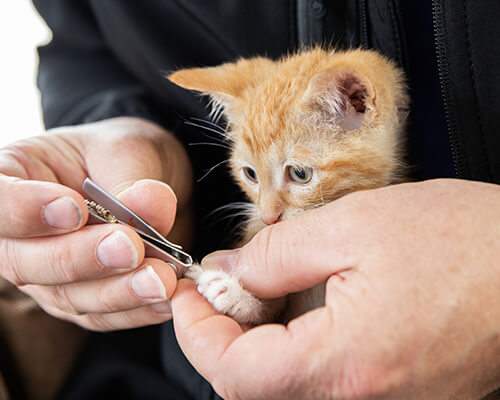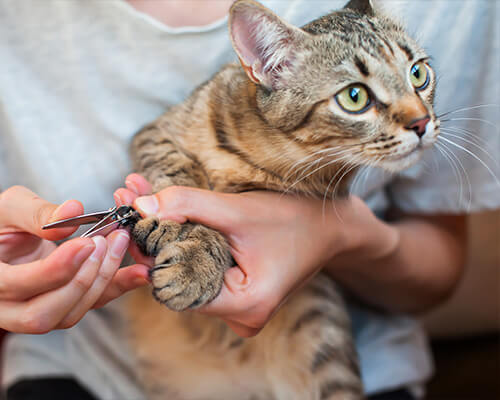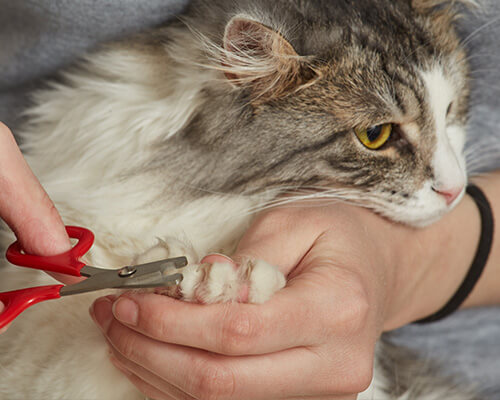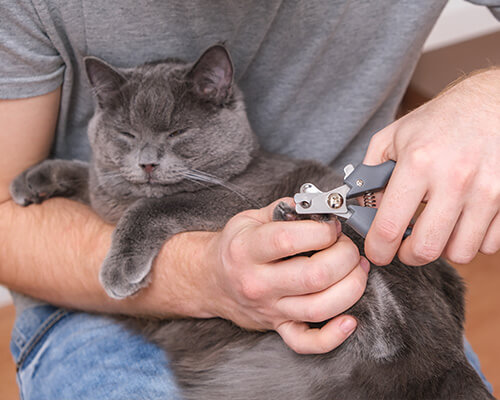Cat Nail Maintenance
While cats may seem like incredibly independent creatures, they depend on you to maintain healthy habits and provide care that as a domesticated cat they may not be able to provide for themselves.
NAIL TRIMMING
Trimming your cat’s nails is an incredibly important routine that can often be overlooked. We’ve seen many cases where a cat’s nails have gotten so long that they curl and grow back into the pads of their feet. As you can imagine, this is incredibly painful for your cat, and much more difficult to trim. It can also easily lead to infection and the need for a trip to the vet for antibiotics. While this is more common in older cats who are less active, it’s also common in cats that live in carpeted homes or don’t get any time outdoors.
Ideally, cats independently wear down their nails. They use scratch pads, trees or walk on hard, outdoor surfaces. Cats who are very active and have access to scratching posts or time outdoors may not need their nails trimmed, but it is important to be regularly checking every few weeks. It’s a great habit to get into when your cat is relaxed on your lap or just lounging around the house.
OVERGROWN NAILS
Still, regular trimming, beginning at a young age, is optimal. It can be difficult to persuade an older cat to become accustomed to a new habit—especially when it involves touching their paws. Not only is regular trimming beneficial for your cat companion long-term, but it’s also beneficial for you and your furniture. Long, sharp nails easily catch on fabric like your clothes, sofa, carpeting or your skin. If grown too long, your cat can even have difficulty retracting their nails. So instead of keeping them safely tucked away, they remain out while they walk. Then, when their nails snag, they can break as they pull away, which can be very painful for your cat who uses its claws for a large variety of things throughout the day from playing to communicating.
To further complicated things, some cats are polydactyly, which means they have extra toes which require extra maintenance. Often times these extra toes don’t touch the ground the way their other toes do. They also don’t have the strength in these toes required to grind down the nails on a scratching post. Regular trimming is especially important for these cats.
CHECKING IN
Check in with your cat every few weeks, but we recommend regular trimming every 4-6 weeks. The best way to check your cat’s nails is to gently hold its paw a very lightly apply pressure to the back of the toes. This pushes the claws forward, allowing you to see how long they’ve grown.
While some people choose to do the trimming themselves, trimming your cat’s nails can be a stressful experience, but it doesn’t have to be. Pawfect Spa helps you and your cat relax during their manicure sessions. Tranquilizers and sedation are never used and two technicians trim the nails, one to hold and soothe and the other to do the work.
THE PRICE OF PREVENTION
A nail trim is certainly worth the cost of maintaining your cat’s health and the integrity of your clothing and furniture. Packages like nail, ears and pads trimming are also offered to prevent ear infections and help them avoid slipping on overgrown hair between their pads.
Luckily, a few regularly scheduled quick clips can help prevent pain, damage and frustration for both you and your beloved friend.




